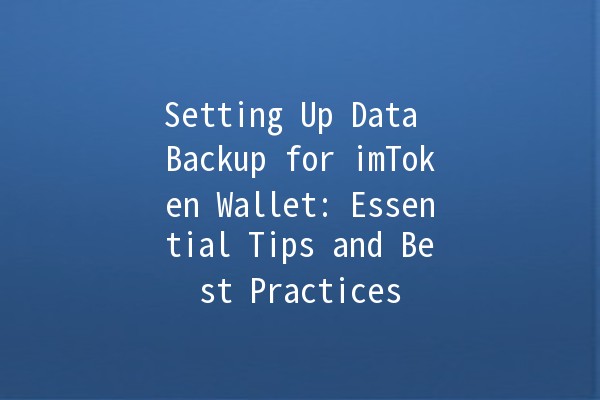In the digital age, managing and securing your cryptocurrencies is paramount. The imToken wallet is one of the most widely used wallets that provides a convenient way to store, manage, and trade various cryptocurrencies. However, with convenience comes responsibility, especially regarding data backup. Setting up proper backup configurations can help safeguard your digital assets from unforeseen data loss or wallet corruption. This article delves deep into the strategies for effectively backing up your imToken wallet data, along with practical tips to enhance your productivity and security.
Before diving into specific techniques for backing up your imToken wallet, let’s explore why data backups are crucial:
Security Against Loss: Digital wallets can be susceptible to device failures, malware attacks, or accidental deletions. A sound backup plan ensures that you don't lose access to your assets.
Peace of Mind: Knowing that your data is securely backed up allows you to use the wallet without the constant worry of potential losses.
Compliance with Best Practices: Regular backups are a standard practice in digital asset management, reflecting a responsible approach towards handling cryptocurrencies.

A seed phrase, or recovery phrase, is a crucial component for backing up your wallet. It’s a series of words generated by your wallet that allows you to restore access to your assets.
How to Use It:
When setting up your imToken wallet, write down your seed phrase and store it in a secure location, such as a safe.
Make sure not to share this phrase with anyone. Anyone with access to your seed phrase can access your funds.
Example: Imagine you've set up a new wallet and are provided with a seed phrase of 12 words. Write it down, doublecheck it, and keep this note in a secure physical or digital location.
Your private keys are what give you access to your cryptocurrencies. Thus, exporting them securely acts as a reliable backup.
How to Export Your Private Key:
Open your imToken wallet and navigate to the wallet you wish to back up.
d the option to export your private key, which might require your password or biometric verification.
Copy the key and store it in a secure, encrypted file or a hardware security module.
Practical Application: If your device is damaged or lost, you can import your private key into a new wallet to regain access to your assets swiftly.
Regular backups of your imToken wallet data can prevent inadvertent losses from occurring.
How to Implement It:
Set a schedule to back up your wallet regularly, such as every month.
Use any cloud storage solution with encryption to keep your backup safe and accessible only to you.
Example: If you trade frequently and make significant changes to your wallet, consider doing this backup weekly to minimize risk.
For advanced users, integrating a hardware wallet adds a layer of security to your backup strategy.
What You Need to Do:
Purchase a reputable hardware wallet such as Ledger or Trezor.
Transfer your assets to the hardware wallet and ensure that the device’s recovery seed is backed up securely.
Use Case: Keeping the majority of your cryptocurrency assets in a secure hardware wallet while using imToken for transactions can minimize exposure to risks, particularly for larger holdings.
Performing regular security checks on your wallet and backup processes is essential.
How to Conduct Audits:
Review who has access to your backup data. Ensure that access codes and private keys are managed responsibly.
Check the latest security practices, including software updates and phishing scams.
Example: Periodically audit your imToken setup and eliminate any outdated devices or user accounts that no longer need access.
The crypto space is rapidly evolving, with new security threats regularly emerging. Stay informed through reliable sources to mitigate risks effectively.
Adding an additional layer of security through MFA can significantly enhance your wallet’s security. Use apps like Google Authenticator for this purpose.
Having multiple copies of your backup in different locations can reduce risks related to theft or damage. For instance, store one backup at home and another in a secure offsite location.
Ensure both your operating system and the imToken app are always updated to the latest versions to protect against vulnerabilities.
Join forums and communities where crypto enthusiasts gather to share security tips and experiences. Engaging with others can provide fresh insights and strategies.
Backing up your imToken wallet should generally be done every month. However, if you make frequent transactions or changes to your wallet, consider doing this weekly.
Yes, your seed phrase is designed to restore access to your entire wallet. However, ensure it is stored securely to prevent unauthorized access.
Unfortunately, if you forget your seed phrase, there is no way to recover your assets. Therefore, it’s critical to store this information safely and in more than one location.
If you choose to store backups in the cloud, ensure the files are encrypted and that you use services with strong security protocols. This can add convenience without sacrificing security.
If your device is lost or stolen, as long as you have your seed phrase or private keys securely backed up, you can restore access through another device or wallet.
No, you should never share your seed phrase or private key. Doing so puts your assets at risk, as anyone with this information can access and withdraw your funds.
By implementing these techniques and maintaining diligent practices, users can effectively manage their data backups for their imToken wallets. The responsibility for safeguarding your assets lies with you; taking these steps ensures a secure and worryfree cryptocurrency experience.